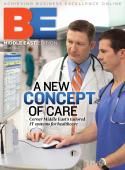Right-sizing healthcareUniversal Health Services balances costs, care, and construction, Jenn Monroe reports. Universal Health Services is doing its part to ensure greater access to healthcare in communities across the country. As one of the largest hospital operators in the US, it both builds new facilities and acquires existing facilities. ÔÇ£We will pursue attractive opportunities, no matter what form they take,ÔÇØ says William Seed, director of facilities design and construction. Alan B. Miller, UHS president and chairman, founded the company in 1978. Today, UHS has approximately 40,000 employees and maintains one of the strongest balance sheets in the industry. ÔÇ£We develop and deliver hospital facilities more efficiently than most,ÔÇØ Seed says.Universal Health Services owns and operates acute care hospitals, behavioral health centers, surgical hospitals, ambulatory surgery centers and radiation oncology centers. At the beginning of this year, it owned, operated or had under construction 31 acute care hospitals and 113 behavioral health centers located in 32 states, the District of Columbia and Puerto Rico. ÔÇ£We try to be the number-one or number-two leader in any given market,ÔÇØ Seed says. ÔÇ£We donÔÇÖt want to be one of ten.ÔÇØFor example, in Las Vegas UHS is the market leader with five hospitals, operating under the Valley Health System name. Centennial Hills Hospital Medical Center is the newest, having opened in January. This 165-bed, eight-story facility cost nearly $100 million and features a 41-bed emergency room, an intensive care unit and 108 medical and surgical beds. Centennial Hills Hospital provides a wide range of medical services and procedures, including outpatient cardiology, outpatient endoscopy, radiology, respiratory, laboratory and pharmacy. It also brings comprehensive womenÔÇÖs services to the region and is NevadaÔÇÖs first tobacco-free hospital campus. At the time of its groundbreaking in July 2005, the Valley Health System Group Director David Bussone said, ÔÇ£ItÔÇÖs a true community hospital. It has the features that we expect the predominance of that population will need.ÔÇØAt any given time, Seed, who is responsible for all construction and physical plant growth for the entire corporation, and his staff of 20 are working on 100 projects. No two are alike, but UHS does follow some of the same basic strategies when building. ÔÇ£We right-size for the services that will be delivered and try not to overbuild,ÔÇØ Seed says. ÔÇ£We also try to design for flexibility for expansion. We try not to land-lock ourselves in terms of acreage as well as space for hospital services in the building.ÔÇØ Centennial Hills Hospital offers an example of this flexibility, as it includes 52,000 square feet of shell space for future expansion. ÔÇ£It comes down to compromise,ÔÇØ Seed says, ÔÇ£what you need versus what you want. ItÔÇÖs a constant balancing act. We try to replicate our good ideas, but most, if not every, development is unique. Every property is unique; every community is unique.ÔÇØ At the moment, Seed and his team are as busy as ever. In early June, UHS broke ground on the replacement Texoma Medical Center hospital in Denison, Texas. Slated for completion in early 2010, the new facility will be ÔÇ£built for expansion.ÔÇØ UHS acquired Texoma Healthcare in January 2007, and the replacement hospital was part of the plan from the start. At the time of the groundbreaking, a local Denison newspaper reported Dr. Mackey Watkins, president and CEO of the medical center, as speaking about the need for this replacement hospital, describing the old building as ÔÇ£too horizontal,ÔÇØ requiring employees to hike up flights of stairs to their work, and ÔÇ£too small,ÔÇØ with not enough private rooms. In California, Universal Health Services is working on a new 171-bed hospital in Palmdale that is scheduled for completion in 2009. The Palmdale Regional Medical Center will be an approximately 250,000-square-foot structure on 37 acres. It will feature OB/GYN services, pediatrics and general medical care. Its 35-bed emergency room will double the current number of UHSÔÇÖ ER beds in the region and will rank as the largest emergency room in the area. Plans call for the addition of 32 intensive care and 36 medical surgical beds in the near future, for a total of 239 beds. In addition to the new hospital, UHS will build two 60,000-square-foot office towers, and the community has decided that a portion of the hospital campus will be devoted to low-income housing for senior citizens. The housing component will provide 60 to 100 independent living apartments for Palmdale seniors. Elsewhere in California, UHS is expanding its emergency imaging and womenÔÇÖs services at its two Southwest Healthcare campuses in Riverside County. On the behavioral health side, UHS opened approximately 1,000 new beds during the past few years and expects to continue its aggressive bed expansion program. To manage all this growth, Seed has placed half his staff regionally, with the other half at Universal Health Services headquarters in King of Prussia, Pennsylvania. ÔÇ£The folks here support those in the field,ÔÇØ he says. In addition to sharing lessons learned electronically, the entire staff meets twice a year, and Seed makes visits to all the regional sites. He also requires each member of his staff to complete one continuing education course or conference each year. His staff is focused on finding partners and forging relationships. He says he is most interested in partners that have a willingness to share problems and concerns and who can work as team. Usually UHS works with regional or local contractors, but it depends upon the size of the program and the size of the community. ÔÇ£We look for honesty, openness, and quality staff,ÔÇØ Seed says. ÔÇ£People who are forward-looking and can get the job done.ÔÇØ┬á









